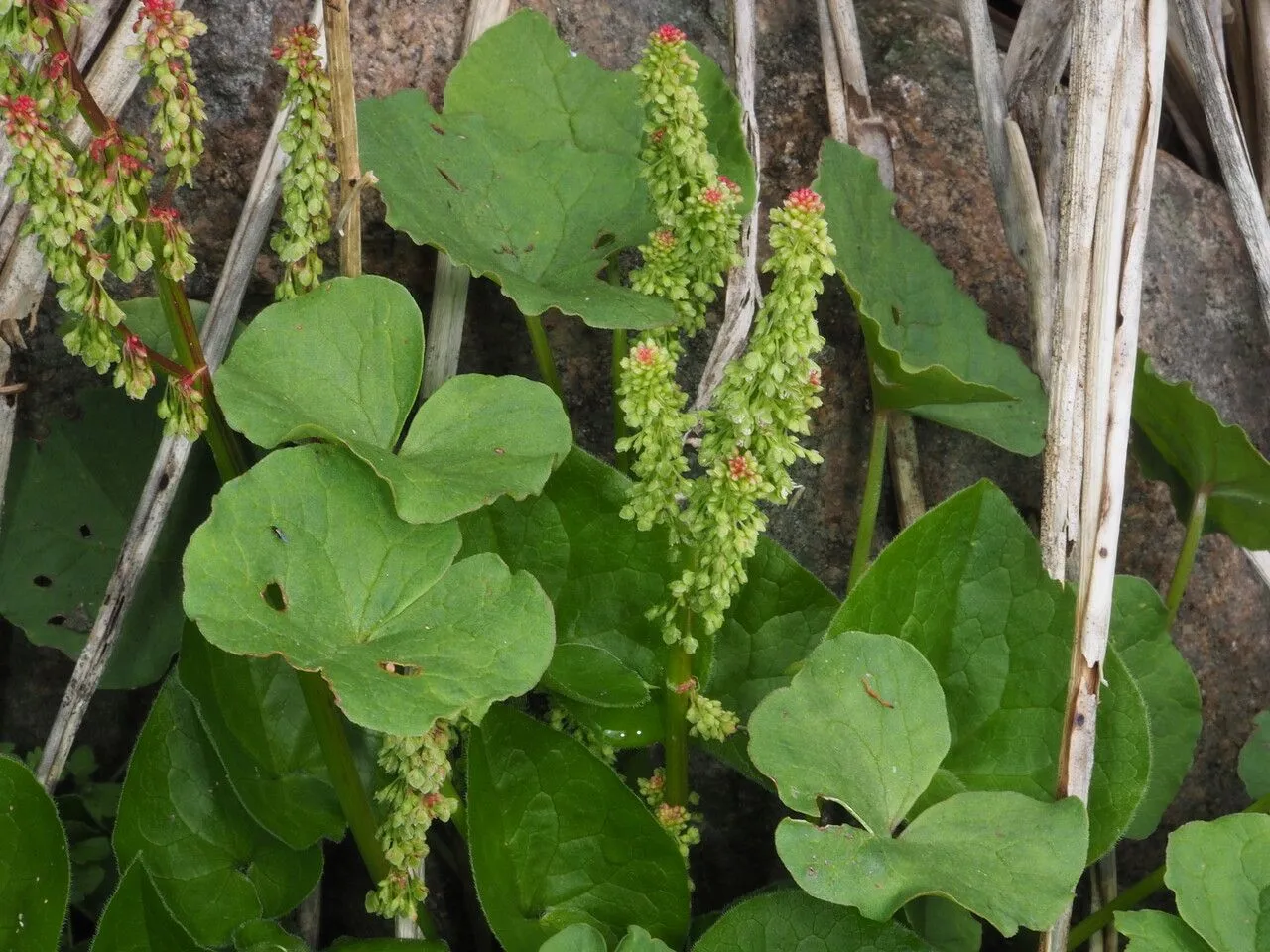
Author: (L.) Hill
Bibliography: Hort. Kew.: 158 (1768)
Year: 1768
Status: accepted
Rank: species
Genus: Oxyria
Vegetable: False
Observations: Subarctic & Subalpine
Alpine mountain-sorrel, scientifically known as Oxyria digyna, is a plant that captures the essence of its rugged environments, thriving in subarctic and subalpine regions. It belongs to the Polygonaceae family, a group renowned for its hardy and resilient members that can endure difficult growing conditions.
Oxyria digyna was first meticulously described in Hortus Kewensis in 1768, a significant botanical work that provided extensive information on various plant species. This particular species boasts a distinguished nomenclature, courtesy of the renowned botanist Hill, who further solidified its place in botanical history.
This perennial herb stands out with its vibrant green, kidney-shaped leaves, which cluster in robust basal rosettes. These leaves are not just strikingly beautiful but also highly adapted to the cold, often nutrient-poor soils in which the plant commonly grows. The foliage, with its slightly sour taste, is edible and has historically been a source of nutrition for indigenous peoples and explorers navigating these inhospitable terrains.
During the blooming season, typically spanning from late spring to early summer, Alpine mountain-sorrel produces delicate, tiny red to purplish flowers arranged in inflorescences. These flowers may be small, but they contribute to the overall aesthetic and ecological value of the plant, playing a role in attracting various pollinators adapted to high altitude conditions.
Oxyria digyna’s ability to flourish in harsh climates makes it an intriguing subject of study for botanists and ecologists. Its presence is a testament to nature’s resilience and the intricate balance of alpine ecosystems. This species is often found on rocky slopes, gravelly areas, and sometimes even on moraines, illustrating its capacity to colonize and stabilize disturbed soils, thereby preventing erosion and supporting other plant and animal life.
The Alpine mountain-sorrel’s remarkable features and ecological significance make it an important species within its native habitats. Its study offers insights into plant survival strategies and contributes to our broader understanding of alpine and subarctic ecosystems.
Deu: alpen-säuerling
Eng: alpine mountainsorrel, alpine mountain-sorrel, mountain-sorrel, mountain sorrel
Dan: fjeldsyre
Ita: acetosa soldanella
Nor: bergsyre, fieldsyre
Swe: fjällsyra
Fra: oxyrie de montagne, oxirie de montagne, oxyrie à deux stigmates, oxyrie à deux styles
Sme: eavru
Cym: suran y mynydd, suran â dalen arennaidd
En: Alpine mountain-sorrel, Mountain-sorrel, Alpine mountainsorrel, Mountain sorrel, Alpine sorrel, Wood sorrel, Iävru
Ar: أوكسيريا ثنائية المأنث
Hy: Թթվախոտ զսպանակավոր
Bg: Киселичник
Ca: Oxíria
Zh: Shan liao, 山蓼
Da: Fjeldsyre
Nl: Alpenzuurkruid, Bergzuring
Et: Harilik põhjaoblikas
Fi: Hapro, Tunturihapro
Fr: Oxyrie de montagne, Oxrie de Montagne, Oxirie de montagne, Oxyrie à deux stigmates, Oxyrie à deux styles, Oxyria à deux styles
De: Alpen-Säuerling
Is: Ólafssúra
Ik: Quŋulliq
It: Acetosa soldanella
Se: Eavru
No: Fjellsyre, Bergsyre, Fieldsyre
Fa: ترشک کوهسری
Pl: Szczawiór alpejski
Ru: Кисличник двустолбчатый
Sr: Руђевица
Sv: Fjällsyra
Bo: Kyurba
Uk: Кисличник двостовпчиковий
Cy: Suran y mynydd, Suran â Dalen Arennaidd
Taken Jul 10, 2015 by Tela Botanica − Yoan MARTIN (cc-by-sa)
Taken Jul 18, 2012 by Tela Botanica − Yoan MARTIN (cc-by-sa)
Taken Aug 29, 2021 by Pietro Brignoli (cc-by-sa)
Taken Oct 27, 2022 by RO Alejandro (cc-by-sa)
Taken Jul 14, 2017 by Yoan MARTIN (cc-by-sa)
Taken Aug 29, 2021 by Pietro Brignoli (cc-by-sa)
Taken Jul 12, 2012 by Tela Botanica − Yoan MARTIN (cc-by-sa)
Taken Jul 10, 2015 by Tela Botanica − Yoan MARTIN (cc-by-sa)
Taken Aug 7, 2005 by Tela Botanica − Alain BIGOU (cc-by-sa)
Taken Aug 23, 2020 by Heini Bachmann (cc-by-sa)
Taken Jul 15, 2009 by Photoflora – Benoit BOCK (©)
Taken Jul 15, 2005 by Photoflora – Benoit BOCK (©)
Taken Jan 1, 1970 by Photoflora – L’Abbé COSTE (©)
Taken Jul 19, 2021 by Renaud Brochiero (cc-by-sa)
Taken Aug 29, 2021 by Pietro Brignoli (cc-by-sa)
Taken Jul 2, 1994 by Tela Botanica − Liliane ROUBAUDI (cc-by-sa)
Taken Aug 5, 2007 by Tela Botanica − Alain BIGOU (cc-by-sa)
Taken Jul 10, 2015 by Tela Botanica − Yoan MARTIN (cc-by-sa)
Taken Aug 7, 2005 by Tela Botanica − Alain BIGOU (cc-by-sa)
Taken May 13, 2021 by Egon Krogsgaard (cc-by-sa)
Taken Jul 14, 2017 by Yoan MARTIN (cc-by-sa)
Taken Jul 18, 2012 by Tela Botanica − Yoan MARTIN (cc-by-sa)
Taken Jul 18, 2012 by Tela Botanica − Yoan MARTIN (cc-by-sa)
Taken Jul 14, 2017 by Yoan MARTIN (cc-by-sa)
Taken Mar 20, 2022 by Martin Bishop (cc-by-sa)
Taken Aug 16, 2017 by Royal Botanic Garden Edinburgh – Hiroshi Ikeda (cc-by-nc)
Taken Jan 1, 1900 by EOL − Niehaus, T.F. (cc-by-nc-sa)
Taken Jul 19, 2012 by EOL − Michael Wunderli (cc-by)
Taken Sep 30, 2012 by EOL − John Brew (cc-by-sa)
Taken Jan 3, 2015 by EOL − podiceps (cc-by-nc)
© copyright of the Board of Trustees of the Royal Botanic Gardens, Kew.
© copyright of the Board of Trustees of the Royal Botanic Gardens, Kew.
© copyright of the Board of Trustees of the Royal Botanic Gardens, Kew.
Growth form: Single Crown
Growth habit: Forb/herb
Growth rate: Moderate
Ph maximum: 8.0
Ph minimum: 6.0
Bloom months: [‘jul’, ‘aug’]
Family: Myrtaceae Author: (F.Muell.) K.D.Hill & L.A.S.Johnson Bibliography: Telopea 6: 402 (1995) Year: 1995 Status:…
Family: Rubiaceae Author: Pierre ex A.Froehner Bibliography: Notizbl. Bot. Gart. Berlin-Dahlem 1: 237 (1897) Year:…
Family: Sapindaceae Author: Koidz. Bibliography: J. Coll. Sci. Imp. Univ. Tokyo 32(1): 38 (1911) Year:…
Family: Asteraceae Author: A.Gray Bibliography: Pacif. Railr. Rep.: 107 (1857) Year: 1857 Status: accepted Rank:…
Family: Fabaceae Author: Medik. Bibliography: Vorles. Churpfälz. Phys.-Ökon. Ges. 2: 398 (1787) Year: 1787 Status:…
Family: Aspleniaceae Author: (Cav.) Alston Bibliography: Bull. Misc. Inform. Kew 1932: 309 (1932) Year: 1932…